Spotting a splash of color in a winter landscape can immediately brighten and add beauty to the dreary, gray days.
Camellia is a good choice for adding color, and important sources of pollinator forage, when most plants have begun months of slumber.
But even though most varieties are semi-tolerant of cold temperatures, and can even continue to bloom through light frost or a dusting of snow, they still need some protection from hard freezes and harsh winds.
We link to vendors to help you find relevant products. If you buy from one of our links, we may earn a commission.
In this guide, we’ll talk about how to keep your camellia protected and thriving through the cold winter months.
Camellias are beautiful flowering shrubs that add a pop of color to winter landscapes. Their flowers range from white to pink to red and bloom from late fall through early spring depending on the variety.
While most camellias are cold hardy, they still need some protection from freezing temperatures and harsh winds during the winter months. Properly wrapping camellias can help prevent cold damage to the buds, leaves, and branches
In this article we’ll go over why camellias need winter protection, materials needed and step-by-step instructions for wrapping outdoor and potted camellias.
Why Wrap Camellias for Winter?
Camellias are native to various parts of Asia and most varieties evolved in milder climates. Though new growth can withstand light frosts, freezing temperatures can damage flower buds and burn foliage and twigs.
Outdoor camellias are especially vulnerable to winter injury. Their shallow root systems are easily exposed to temperature fluctuations in the soil. Potted camellias are also at risk because the entire plant is exposed to the elements.
Wrapping camellias provides an insulating barrier against the cold and wind. It prevents frost from forming directly on the plant. The goal is for frost to form on the outside of the wrap instead of on the shrub itself.
Materials Needed for Wrapping Camellias
- Horticultural fleece, burlap, or bubble wrap
- Twine or string
- Garden stakes or bamboo canes
- Scissors
The best wrap material is lightweight horticultural fleece. It allows air and light penetration but still insulates the plant. Other options like burlap and bubble wrap also work. Avoid using plastic sheets as they don’t allow ventilation.
How to Wrap Outdoor Camellias
Follow these steps to properly wrap and insulate outdoor camellias:
-
Water the plant well before the ground freezes. Moist soil helps insulate the roots.
-
Apply 2-4 inches of shredded wood or bark mulch at the base. Spread it over the root area.
-
Insert garden stakes or bamboo canes around the shrub. Space them 12-18 inches apart. Leave them a few inches taller than the top of the plant.
-
Wrap the shrub with horticultural fleece, burlap, or bubble wrap. Make sure to overlap it and use multiple layers if needed.
-
Use twine to tie and secure the wrap material to the stakes. Don’t tie it directly to the branches.
-
Cover the top of the plant with excess material and tie it to the stakes to seal it.
-
Add horizontal twine across the sides to keep the wrap from billowing in wind.
-
Remove the wrap in early spring after the threat of frost has passed.
How to Wrap Potted Camellias
Follow these tips for protecting container-grown camellias:
-
Move the pots to an unheated garage or greenhouse before temps drop below 25°F. Avoid warm, dry indoor areas.
-
Group the pots together to insulate the roots. Cover the soil with mulch.
-
Water whenever the soil feels dry. Lower humidity indoors increases water needs.
-
Wrap the plants with insulation as described for outdoor camellias.
-
Move the camellias back outside in spring after the chance of frost has gone. Do it slowly over a week to avoid shock.
Other Winter Protection Tips
Here are some other things you can do to help your camellias survive cold winter weather:
-
Choose cold-hardy varieties suitable for your climate zone. Some tolerate temps down to 5°F.
-
Plant camellias in protected areas away from harsh winds. Insulate with a fence, wall, or evergreen windbreak.
-
Avoid late season fertilizing which can trigger tender new growth before a freeze.
-
Prune out any dead or damaged wood in early spring after new growth resumes.
Wrap Up
Properly wrapping camellias for winter is easy and goes a long way in protecting them from cold damage. Pay attention to weather forecasts and wrap plants whenever freezing temperatures are predicted.
With a little fall preparation and TLC, your camellias will thrive through winter and give you beautiful early spring blooms year after year.
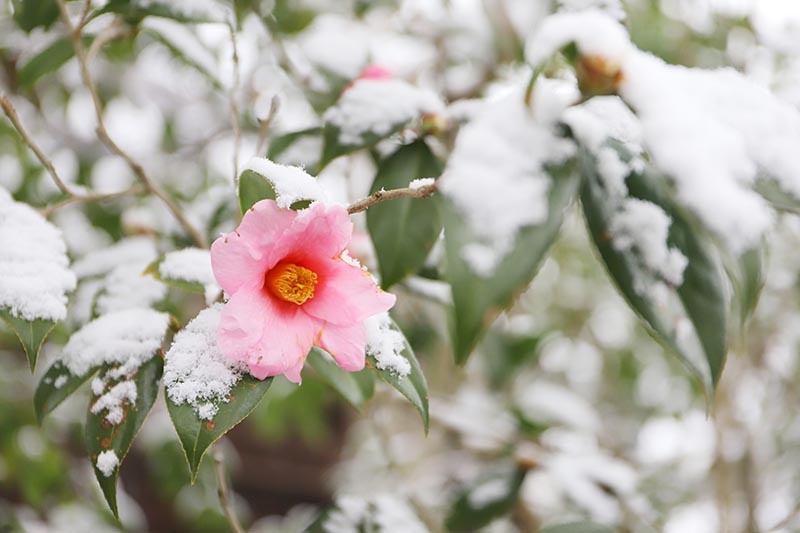
Tips for Outdoor Winterizing
First and foremost, choose a variety that is suited to your region if you intend to leave it outdoors throughout the winter, and be sure to set it in a location that is as protected from cold winds as possible.

It’s also important to shelter the roots, but avoid smothering them, as they are highly sensitive.
Be sure to avoid fertilizing late in the summer or in the fall. Fertilizing can cause it to produce new growth, and boosting plant growth just as winter weather conditions take hold will almost certainly kill the new shoots.
Allow your plants to begin to fall into dormancy as the weather chills. Dormant plants are more tolerant of winter weather, and can be more easily protected through the rest of the season.
As temperatures fall, water deeply, as moist soil can help to insulate roots. It’s also important to provide water ahead of time as the plant will not be able to draw moisture from the frozen ground.
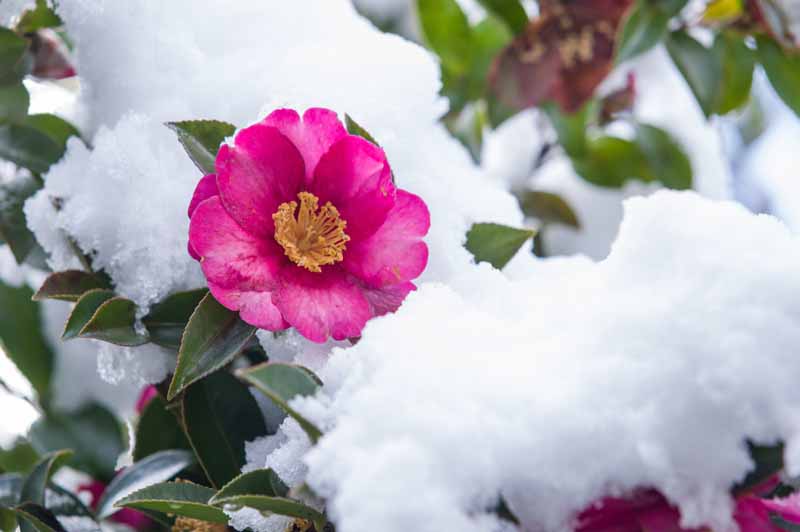
A thick layer of two to four inches of mulch can be applied at the base of each plant, spread to the width of the canopy – or the outer circumference of the shrub – to cover roots that are close to the surface of the ground.
Camellias are typically planted shallowly as the roots need good aeration, and roots can often be positioned near ground level.
Shredded or chipped wood mulch or straw work best, as these allow for air transpiration without becoming matted down, which is important for the roots. Be sure to apply mulch prior to hard freezes, especially if extreme cold is predicted.
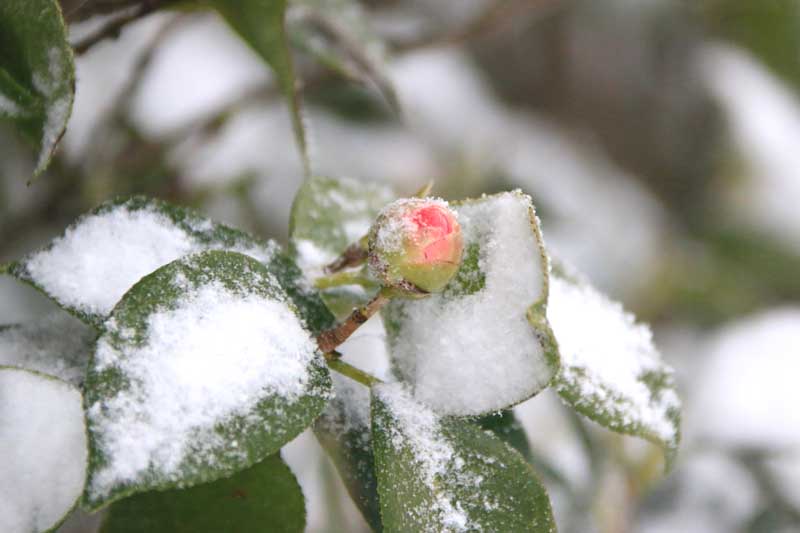
Avoid using leaf mulch as it can become matted when wet, creating a smothering layer on top of the roots. Leaves can be used if they’re well shredded to prevent matting from becoming an issue.
It’s a good idea to replace the mulch annually as they are woodland plants, and mulch can mimic the typical environment of the forest floor throughout the year.
Mulch can also be left in place to help to retain moisture and keep temperatures at the roots cooler in the hotter months.
In areas where temperatures can dip well below freezing, you should wrap your shrubs for additional protection. Plants can be wrapped in layered horticultural fleece, burlap, or bubble wrap.
If extremely low temperatures are expected, materials can be doubled or tripled up, provided that light can still filter through.
If you’d prefer a canopy-style barrier, you can find these at Home Depot. Just be sure to fasten it securely in place to prevent it from becoming a kite!
Wrap plants loosely to allow for air circulation and transpiration.
But be sure to secure it well to avoid having to chase errant wrapping material through the yard on a windy day.
Twine or twist ties can be used to bind the wrapping material to bamboo canes or metal stakes to keep things in place.
Don’t tie material directly to the branches, as this could cause damage if the plant can’t support the weight of snow or withstand strong winds.
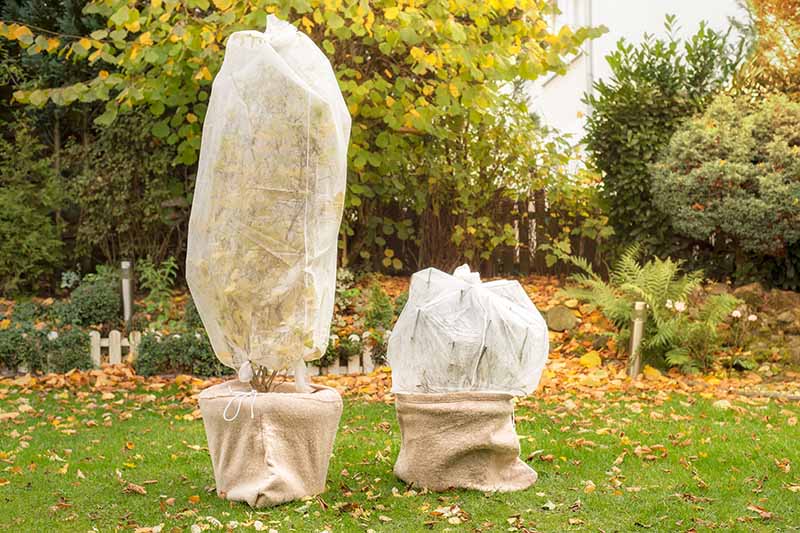
After the threat of frost has passed, the wrapping can be removed. If your plant normally blooms before the last threat of frost has passed, however, you can remove the wrapping ahead of time, and rewrap it when frost is expected.
Even when precautions are taken, you may notice some discoloration of the foliage. Camellia leaves are evergreen, meaning that they don’t drop in the fall, and winter burn or frost can damage them.
Normally, yellowing will self-correct as spring rolls around, but any foliage or branches that die off should be pruned away in the spring.
If you’re seeing a lot of discoloration, consider adding additional wrapping, but don’t layer it so thickly that light is not able to penetrate to the plant.
If you pick a variety that can not tolerate the low winter temperatures and conditions in your area, you will most likely need to grow it in a container so you can move your shrub to a sheltered area.
So, what’s the plan for moving the potted plant? Let’s explore some options.
Why Do Camellias Need Winter Protection?
All varieties of camellia originated in various parts of Asia, thousands of years ago. Their beauty, charm, and usefulness established them as a coveted addition to the garden.
In China and Japan, these shrubs have been widely adored for quite some time, and included as an important part of religious observances and imperial ceremonies.
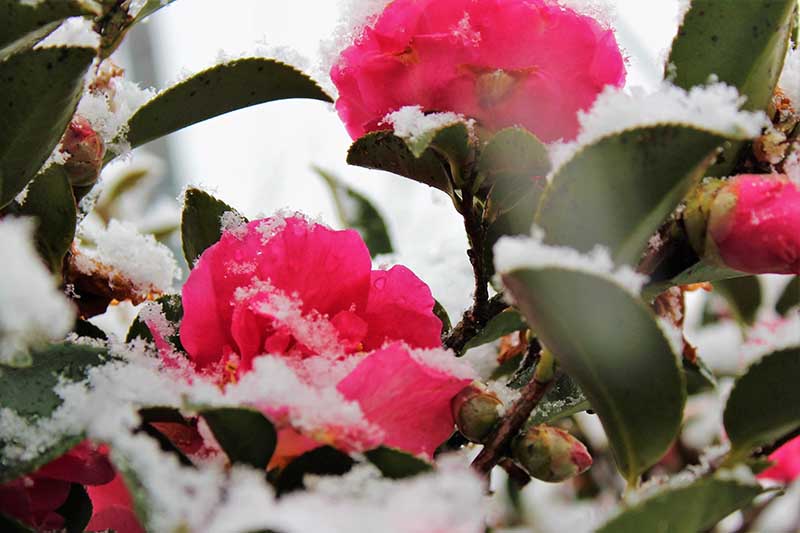
In fact, some of the camellia plants gracing many palace gardens in the region today were planted more than five hundred years ago.
Read more about the long history of camellias and how to grow them in our guide.
While many varieties are cold hardy or cold tolerant, even these can suffer winter damage in extremely low temperatures or from exposure to harsh, cold winds.
Potted camellias can be moved into a greenhouse or garage, or a more sheltered area outdoors, for winter protection.
But beware of dry conditions inside temperature-controlled areas in winter. Camellias are not best suited for these, and rehoming your plants in a warm and dry location for the winter may lead to death.
Preventative measures and a little forethought are necessary to get your camellia through the winter months safely. Let’s discuss the best methods for protecting your plants.
How I Winterize Camellias in Pots.
FAQ
How to wrap camellias for winter in winter?
- Cover the root zone with a breathable garden fleece, a coconut mat or a thick layer of mulch.
- Additional protection can be provided by a warm layer of spruce branches, brushwood, leaves or moss.
How to overwinter camellias?
Move the container nearer to the house or to a sheltered corner. Wrap camellias with horticultural fleece. Alternatively, move potted camellias into cold a greenhouse or cool conservatories in spells of freezing weather.
Can camellias tolerate freeze?
CAMELLIAS AND THE COLD: Open flowers of camellias can be damaged by temperatures below freezing, but the buds are generally not damaged. They will bloom normally later on. Camellia bushes appreciate a mulch 2 or 3 inches thick over their roots to help keep the soil evenly moist.
Can camellia plants live in their potted container over winter?
As a rule of thumb, growing plants in containers shifts hardiness by approximately two zones. For winter survival, it is necessary to select container plants from two zones colder than your USDA Hardiness Zone. Newer cold-hardy camellias like October Magic® Bride have pushed camellias into more northern gardens.
Do camellias need to be wrapped?
Camellias are native to parts of Asia with mild winters When camellias are grown in zones with cold winters, they need some protection to avoid damage Freezing temperatures can damage buds, leaves, and branches. Wrapping camellias protects tender new growth and flower buds from being damaged by frost and freeze.
Should you wrap a camellia in winter?
Patricia Short, UK-representative of the International Camellia Society, recommends wrapping some bubble wrap or other form of protection around camellia shrubs during extremely cold winters.
How do you care for a camellia in winter?
Winter care, therefore, will usually require more thought if you are growing a particularly tender type of camellia. You may need to think about moving tender types to a more sheltered and warmer location, or wrapping the shrub in horticultural fleece or some reclaimed fabric to protect buds and early flowers.
How do you protect a camellia tree from frost?
Cover the top to protect the crown and buds from frost. Check for pests over winter. Unwrap the camellia in early spring after the risk of frost has passed. Focus protection on the main branches, crown, and buds but avoid tightly wrapping the leaves themselves. Make sure the entire shrub is covered top to bottom.
Do camellias need winter protection?
Proper winter protection results in abundant, lush blooms come springtime. Timing is important when it comes to winter protection. Camellias should be wrapped in late fall after they have gone dormant. This is usually after the first hard frost when the plants have hardened off for winter.
Can camellias overwinter?
In USDA hardiness zones 7 and higher, many types of camellias easily overwinter outdoors, as some can handle temperatures as cold as 5 degrees Fahrenheit. To know if you need to protect your plant throughout winter, check your local temperatures and recommendations for the kind of camellia shrub you’re growing.
